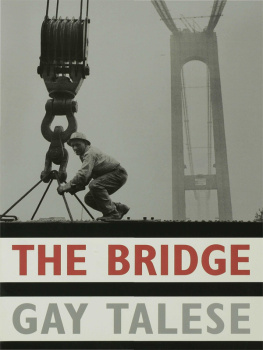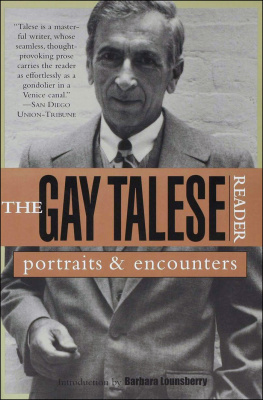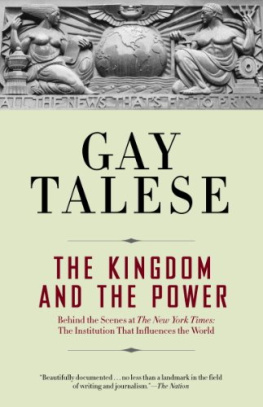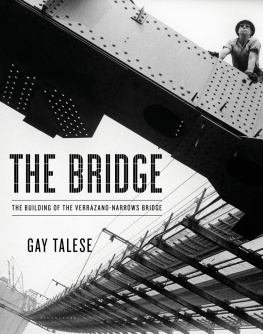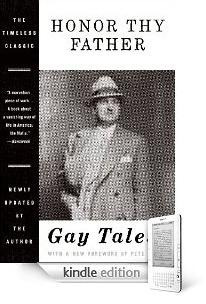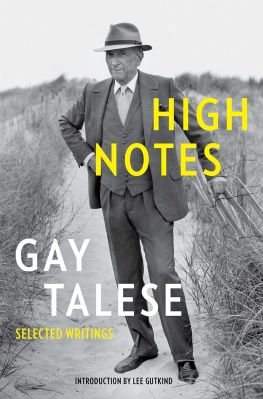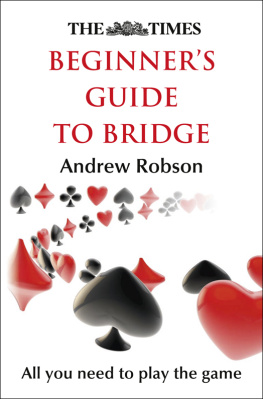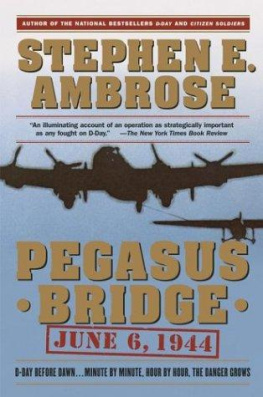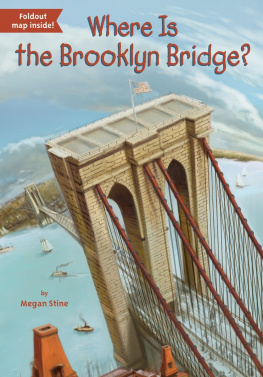Gay Talese - The Bridge, New preface, afterword, illustrations, and photographs
Here you can read online Gay Talese - The Bridge, New preface, afterword, illustrations, and photographs full text of the book (entire story) in english for free. Download pdf and epub, get meaning, cover and reviews about this ebook. year: 2003, publisher: Walker & Company, genre: Detective and thriller. Description of the work, (preface) as well as reviews are available. Best literature library LitArk.com created for fans of good reading and offers a wide selection of genres:
Romance novel
Science fiction
Adventure
Detective
Science
History
Home and family
Prose
Art
Politics
Computer
Non-fiction
Religion
Business
Children
Humor
Choose a favorite category and find really read worthwhile books. Enjoy immersion in the world of imagination, feel the emotions of the characters or learn something new for yourself, make an fascinating discovery.
- Book:The Bridge, New preface, afterword, illustrations, and photographs
- Author:
- Publisher:Walker & Company
- Genre:
- Year:2003
- Rating:4 / 5
- Favourites:Add to favourites
- Your mark:
- 80
- 1
- 2
- 3
- 4
- 5
The Bridge, New preface, afterword, illustrations, and photographs: summary, description and annotation
We offer to read an annotation, description, summary or preface (depends on what the author of the book "The Bridge, New preface, afterword, illustrations, and photographs" wrote himself). If you haven't found the necessary information about the book — write in the comments, we will try to find it.
The Bridge, New preface, afterword, illustrations, and photographs — read online for free the complete book (whole text) full work
Below is the text of the book, divided by pages. System saving the place of the last page read, allows you to conveniently read the book "The Bridge, New preface, afterword, illustrations, and photographs" online for free, without having to search again every time where you left off. Put a bookmark, and you can go to the page where you finished reading at any time.
Font size:
Interval:
Bookmark:
"Only a writer in love with his subject could have produced so charming a narrative about a bridge. There are many stories within the story of The Bridge. All are worth reading."
Houston Post
"Talese has spun a fascinating, engrossing account of the construction of the Verrazano-Narrows Bridge. This is an absorbing drama; superbly written."
Times Union (Jacksonville)
"No finer tribute in print will ever be found than this book."
Wilmington News Journal
"Talese tells warm, funny and tragic stories of men, women, steel and concrete. This book is fine reading."
Denver Post
"Fine writing and story-telling.... Superbly well does Talese tell his story, one that combines sadness, high humor, bawdiness, danger, death and poignancy in one fine package that readers will find hard to put down."
Arizona Republic
"Talese is a shining example for all writers. He gets the drift of the story.... A complete, informative and fascinating account of the bridge."
Times (Indianapolis)
THE BRIDGE

GAY TALESE
______________________________________
THE BRIDGE
To the ironworkers
________________________________________________________________
especially Gerard McKee and Danny Montoor
Preface and afterword copyright 2003 by Gay Talese
Text copyright 1964 by Gay Talese
Lili Rethi illustrations and all photographs copyright 2003 by
MTA Bridges and Tunnels Special Archive
All rights reserved. No part of this book may be reproduced or transmitted in any form or by any means, electronic or mechanical, including photocopying, recording, or by any information storage and retrieval system, without permission in writing from the Publisher.
First published in the United States of America in 2003 by Walker Publishing Company, Inc.
Published simultaneously in Canada by Fitzhenry and Whiteside, Markham, Ontario L3R 4T8
For information about permission to reproduce selections from this book, write to Permissions, Walker & Company, 435 Hudson Street, New York, New York 10014
Original captions for Lili Rethi's on-site illustrations by H. George Decancq, Resident Engineer, Field Office, Ammann and Whitney
Library of Congress Cataloging-in-Publishing Data
available upon request
eISBN: 978-0-802-71913-3
Book design by Maura Fadden Rosenthal/mspace
Visit Walker & Company's Web site at www.walkerbooks.com
Printed in the United States of America
2 4 6 8 10 9 7 5 3 1
CONTENTS
APPENDIX: FACTS ABOUT THE
VERR AZANO-NARROWS BRIDGE
A great bridge is a poetic construction of enduring beauty and utility, and in the early 1960s I would often don a hard hat and follow the workers across the catwalk of the Verrazano-Narrows Bridge and watch for hours as they crawled like spiders up and down the cable ropes and straddled beams while tightening bolts with their spud wrenches; and sometimes they would give a shove with their gloved hands against a stalled spinning wheel, or would bang a shoulder against a two thousand-pound piece of framework dangling from a cranethe framework representing one of millions of links in the rainbow-shaped roadway that would extend for two and a half miles horizontally across the Upper Bay of New York to connect the boroughs of Brooklyn and Staten Island, spreading discontent and trepidation among residents of both places.
I was less interested in the mundane matters of expanded land development and increased auto traffic and the potential of unwanted new neighbors than I was in observing the process by which artistry is achieved in the air through the fusion of drawing-board ingenuity and steely nerved bridge builders, both groups of men leaving a lasting impression on the skyline of New York and enhancing its spirit of grandiosity. The Verrazano-Narrows Bridge, the longest suspension span in the nation, is dominated by two towers each seventy stories high, and from these vantage points one can survey the panorama of the citythe Empire State Building, the Chrysler Building, the venerable Brooklyn Bridge, completed in 1883, the spires of Wall Street, and, until September 11, 2001, the 110-story twin towers of the World Trade Center.
When I first moved to New York, a half-century ago, I often asked myself: Whose fingerprints are on the bolts and beams of these soaring edifices in this overreaching city? Who are the high-wire walkers wearing boots and hard hats, earning their living by risking their lives in places where falls are often fatal and where the bridges and skyscrapers are looked upon as sepulchers by the families and coworkers of the deceased? We often know the names of the architects or chief engineers of renowned structures, but those men whose job it is to ascend to high and dangerous placesthe kind of men who erected and connected the steel on the Empire State Building or spun the cables across the Brooklyn Bridgeare not identified by name in the books, archival materials, or other written accounts concerned with the construction of these landmarks.
I kept this in mind when I decided, in 1962, to write about the Verrazano-Narrows Bridge construction; it would include the names and biographical information about the workers, establishing their rightful place in the history of this grand undertaking. Now I am particularly gratified that nearly forty years after the hardcover publication of The Bridge in 1964, a paperback edition is being made available. Several of the individuals featured in the original work are dead, while other hard-hatted veterans of the Verrazano are not only alive but are still earning their living on high steel. I have included additional information about these men and other individuals who were involved with the story in an afterword following this edition's final chapter.
THE BRIDGE

They drive into town in big cars, and live in furnished rooms, and drink whiskey with beer chasers, and chase women they will soon forget. They linger only a little while, only until they have built the bridge; then they are off again to another town, another bridge, linking everything but their lives.
They possess none of the foundation of their bridges. They are part circus, part gypsygraceful in the air, restless on the ground; it is as if the wide-open road below lacks for them the clear direction of an eight-inch beam stretching across the sky six hundred feet above the sea.
When there are no bridges to be built, they will build skyscrapers, or highways, or power dams, or anything that promises a challengeand overtime. They will go anywhere, will drive a thousand miles all day and night to be part of a new building boom. They find boom towns irresistible. That is why they are called "the boomers."
In appearance, boomers usually are big men, or if not always big, always strong, and their skin is ruddy from all the sun and wind. Some who heat rivets have charred complexions; some who drive rivets are hard of hearing; some who catch rivets in small metal cones have blisters and body burns marking each miss; some who do welding see flashes at night while they sleep. Those who connect steel have deep scars along their shins from climbing columns. Many boomers have mangled hands and fingers sliced off by slipped steel. Most have taken falls and broken a limb or two. All have seen death.
They are cocky men, men of great pride, and at night they brag and build bridges in bars, and sometimes when they are turning to leave, the bartender will yell after them, "Hey, you guys, how's about clearing some steel out of here?""
Next pageFont size:
Interval:
Bookmark:
Similar books «The Bridge, New preface, afterword, illustrations, and photographs»
Look at similar books to The Bridge, New preface, afterword, illustrations, and photographs. We have selected literature similar in name and meaning in the hope of providing readers with more options to find new, interesting, not yet read works.
Discussion, reviews of the book The Bridge, New preface, afterword, illustrations, and photographs and just readers' own opinions. Leave your comments, write what you think about the work, its meaning or the main characters. Specify what exactly you liked and what you didn't like, and why you think so.

